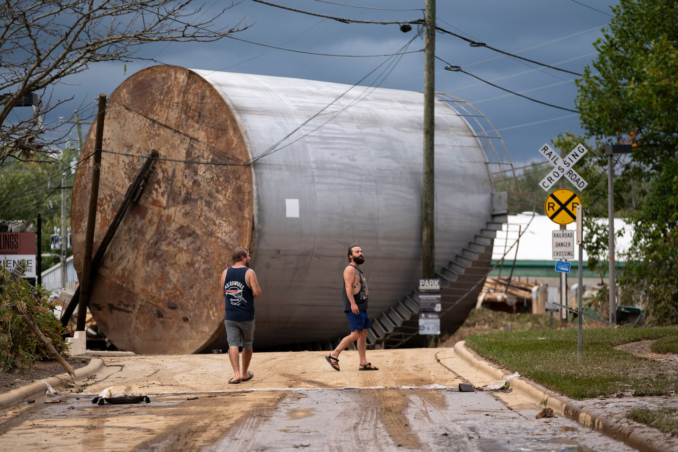Hurricane Helene devastation – forewarning of what’s to come
Year after year the average temperature of the world’s atmosphere and oceans is increasing. The rapid growth of Hurricane Helene into the most powerful category of tropical cyclones before it made landfall Sept. 26 confirms the impact of higher temperatures on weather.
The question of the impact of temperature on climate — the average of weather over time — is not entirely settled, but it is hard to ignore. Since higher temperatures usually mean more powerful storms, to effectively track storms requires awareness of a temperature’s effect.

Water tank swept off its mooring, Biltmore Village, North Carolina, Sept. 29, 2024.
Before the National Weather Service started tracking hurricanes and issuing warnings about their tracks, hurricanes were very deadly. The hurricane which hit Galveston, Texas, in 1900 directly caused between 6,000 to 12,000 deaths. Other than the deaths directly caused by Hurricane Katrina (1,392), all of the hurricanes that have hit the U. S. directly caused less than 450 deaths; most much less.
However, a study published by the journal “Nature” on Oct. 2, established that for the 501 hurricanes that have hit the contiguous United States since 1930, the average hurricane leads to as many as 11,000 “excess” deaths after direct hits.
The study points to Hurricane Helene’s lasting damage to homes, health systems, economies and social networks.
People over 65 were disproportionately affected as well as infants, including those who were born after the hurricane hit. The excess deaths are concentrated in the poorer Black communities and among the youngest members of the affected areas. For any given storm, the study shows, a Black victim is three times more likely to die than a white person.
When Hurricane Helene hit the big bend area of Florida’s Gulf Coast, it had absorbed a tremendous amount of energy from the super warm waters of the Gulf Coast becoming unusually wide and powerful. As it moved quickly inland it didn’t encounter dry soil conditions that generally rob hurricanes of their strength. Warm rains preceded it by a few days, so Helene was met by warm, wet soil until it hit the mountains of western North Carolina.
There it dumped all of the moisture it had collected from the Gulf. Months worth of rain came down in three days resulting in devastating floods and mudslides.
To avoid the deaths that these floods caused, the county authorities of Buncombe County, the county which includes Asheville, would have had to arrange for evacuations based on flood zones. They were indeed aware that a “flood event called Helene” was headed their way.
But the flood zone maps for Buncombe were last updated in 2010 (with updates scheduled for 2026), and no evacuation routes had been established in an area where most roads are narrow and twisty.
An areawide notification system was also missing. Even the limited, last moment notices given were only in English, despite 6% of the county’s population being Spanish-speaking.
The authorities decided that people staying put was the safest way to respond to the storm.
It wasn’t!

